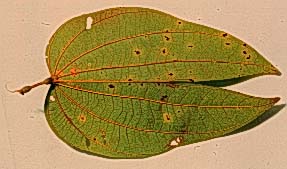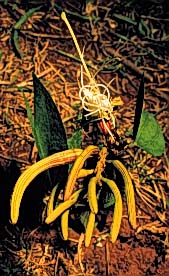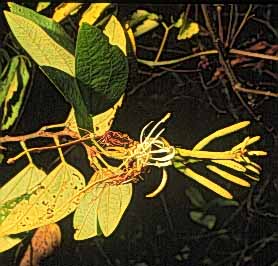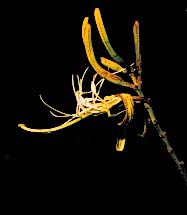
Bauhinia ungulata
Casco de Venado
(Fabaceae)
|
Bauhinia ungulata Casco de Venado (Fabaceae) | |
Masís, A., Espinoza, R., Guadamuz, A., Perez, D. y Chavarría, F. 1998. Bauhinia ungulata (Fabaceae) Species Page, 18 January 1998. Species Home Pages, Area de Conservación Guanacaste, Costa Rica. http://www.acguanacaste.ac.cr
I. Identificatión:
Shrub up to 5 m tall (Espinoza 1998).
Flower:
In general, flowers appear white but in detail they are light pink.
|
Dissected flower | |
 | |
Inflorescence | |
The flower is perfect (both male and female reproductive structures present in the same flower). The inflorescence is a terminal raceme that opens early in the evenning. Flowers only during a few days.
 |
 |
Inflorescence | |
Fruit:
The inmature legumes (name given to the Fabaceae fruits) are light brown on one of its side and green on the other.
It is a dehiscent fruit.
|
Inmature fruit |
Dissected inmature fruit |
|
Mature and inmature fruit |
Mature fruit |
|
Inmature seed | |
Leaves:
Bauhinia ungulaa leaves are very distinctive and characteristic because they are incompletely divided in two. The common name Casco de veneado (Deer hoof) is given because of this characteristic leaf shape.
Aproximately 6-12 cm in length.
|
Under surface |
Upper surface |
|
Detail of the under surface |
Detail of the upper surface |
Leaves are simple and alternate, dark green on the upper surface while the under surface is light green.
Petiole cilindrical and about 0.5-2 cm in length.
|
Leaf arrangement |
Bark and wood:
The bark has a fine reticulation, an it is dark brown. The wood in cream color.
 |
|
External and internal bark |
Similar species:
It might be mistaken with Bauhinia pernetia, but the diagnostic characteristic for Bauhinia pernetia are its spines on the trunk and branches. According to Espinoza (1998) Bauhinia pernetia is not very common and he only remembers seeing one individual on the road to Chiringon in Sector Santa Rosa.
Bauhinia divaricata leaves look like those of ungulata, but divaricata is a woody liana that climes to the canopy. The liana looks like a ladder and for this characteristic its given the common name monkey ladder. This species occurs humid areas like Estación biológica Pitilla, Cacao and Sectores Pailas and Santa María (Rincón de la Vieja).
Verification:
II. Geographic distribution:
International:
In Costa Rica:
Found in lowland semi-deciduous and deciduos forests.
In the Area de Conservación Guanacaste:
In the lowland semi-deciduous and deciduos habitats that are represented in the Area de Conservación.
Maps of macro-habitats of the
ACG |
III. Natural history:
It is a caducifoilious species that imediately puts new leaves out after dropping the old ones.
IV. How to find:
It is possible to find individuals along the Interamerican highway and on the sides of the roads and trails in Sector Santa Rosa and Sector El Hacha near Los Almendros station.
Acknowledgments:
This project was carried out by the Area de Conservación Guanacaste/CR, with help from INBio/CR, ICBG from the Foggarty center, NIH/USA and NSF/USA.
Literature cited:
Espinoza, R. 1998. Programa de Investigación. Area de Conservación Guanacaste. Com.pers.